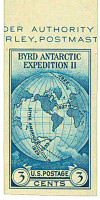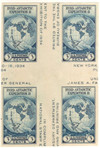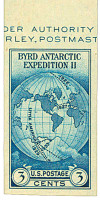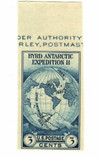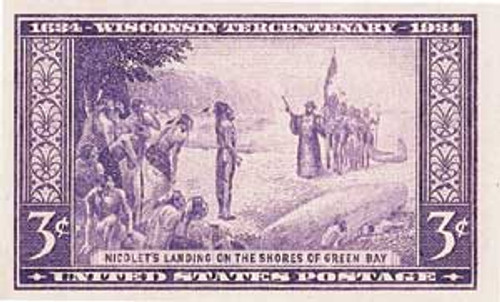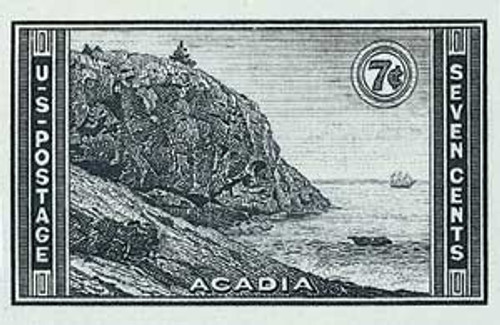
# 768a - 1935 3c Byrd Expedition, no gum, imperf single
U.S. #768a
1935 3¢ Byrd Expedition
Issue Date: March 15, 1935
First City: Washington, DC
Quantity Issued: 267,200 souvenir sheets
The 1934 souvenir sheet publicizing Rear Admiral Richard Byrd’s second expedition to the South Pole was issued in conjunction with the 1934 National Stamp Exhibition held in New York. The same design was reissued in 1935, imperforate and ungummed, along with the others, which became known as “Farley’s Follies.”
What are Farley’s Follies?
Farley’s Follies is one of stamp collecting’s most interesting stories. And since most of the stamps are readily available and inexpensive, it’s easy enough to put a specialized collection together. Let’s step back in time and discover one of the Postal Service’s biggest scandals…
James A. Farley (1888-1976) got his start in politics in 1911 as town clerk of Grassy Point, New York. He moved his way through the political system, forming the Upstate New York Democratic Organization and bringing many upstate voters to the Democratic party. In 1924, he met young Franklin Roosevelt at the Democratic National Convention. Four years later, FDR asked Farley to run his campaign for New York governor. Farley helped FDR win the elections for governor in 1928 and 1930. A driving force in the US political system, Farley helped FDR win the 1932 and 1936 presidential elections. Roosevelt made Farley his Postmaster General. Farley was pivotal in turning around the US Post Office Department. He helped the department finally turn a profit and revolutionized airmail service.
The infamous “Farley’s Follies” controversy began in 1933 when Farley removed several stamp sheets from the printing presses before they were gummed or perforated. He autographed these sheets (which were not available to the public) and gave them to colleagues and family, creating precious philatelic rarities. Stamp collectors were outraged when they discovered what had happened. Finally, the Post Office came up with a solution – the reissue in sheet form of all the stamps issued since March 4, 1933, in ungummed condition, all but the first two imperforate and in sufficient numbers to satisfy public demand. Although Farley and FDR had a falling out over Roosevelt’s plan to run for a third term, Farley remained a strong force in the political and business worlds. He went on to serve as Chairman of the Board of the Coca-Cola Export Corporation and served as a trusted advisor to several Popes, dignitaries, and Presidents until his death in 1976.
Farley’s Follies are Scarce and Valuable Collectibles
The British stamp firm Gibbons reportedly declared the reprint was “nauseous prostitution,” and at first refused to list the issues in their famous stamp catalog! But even today, over 80 years after they were issued, collectors still love Farley’s Follies.
“Farley’s Follies” were issued in large sheets that are way too big to fit in stamp albums. So smart collectors snapped up blocks and pairs in a variety of formats instead. They not only fit, but these key formats are an easy way to understand the stamp printing process.
Mystic purchased full sheets of these mint stamps and made them available in scarce formats like vertical, horizontal and gutter pairs plus arrow blocks, line pairs and cross gutter blocks. All are hard to find – some occur only once in every stamp sheet. It’s a neat way to own a scandalous slice of US postal history.
Richard Byrd – Antarctic Explorer
Richard Evelyn Byrd was born on October 25, 1888, in Winchester, Virginia.
Byrd was descended from one first families of Virginia – among his ancestors were John Rolfe and Pocahontas. Byrd attended the Virginia Military Institute and the University of Virginia before enrolling in the U.S. Naval Academy.
After graduating in 1912, Byrd was assigned to the USS Wyoming and later the USS Dolphin. Aboard this ship he met then Assistant Secretary of the Navy Franklin D. Roosevelt and participated in the U.S. intervention in Veracruz, Mexico. After suffering a foot injury, Byrd medically retired from the Navy and then joined the Rhode Island Naval Militia. He also recognized the expanding future of aviation and earned his pilot wings in 1917.
During World War I, Byrd worked in the Office of Naval Operations and trained pilots. He also commanded naval air forces in Nova Scotia. After the war, Byrd created the flight path for the Navy’s 1919 transatlantic crossing. Then in 1925 he commanded the aviation unit of an arctic expedition, which inspired him to launch an expedition of his own.
In May 1926, Byrd and Floyd Bennett reported that they made the first recorded flight over the North Pole. Byrd returned home a national hero, was promoted to the rank of commander, and received the Medal of Honor. There was later some controversy over whether they actually did fly over the North Pole, but Byrd used the fame from this trip to plan a flight over the South Pole.
Two years later, Byrd launched that expedition and on November 28, 1929, made the first flight to the South Pole and back. For this achievement, he was promoted to rear admiral, making him the youngest admiral in the U.S. Navy, at age 41.
Byrd returned to the Antarctic in 1934 for a solo mission. He spent five months alone in a meteorological station, where he suffered carbon monoxide poisoning from an ill-ventilated stove. He was later rescued and recounted the tale in his autobiography Alone. The U.S. Post Office issued #733 to commemorate this expedition, though the stamp wasn’t distributed for public sale. Rather, it was issued for use on letters mailed through the Little America Post Office that was established at the base camp of the Byrd Antarctic Expedition in the territory of the South Pole.
Byrd launched a third Antarctic expedition in 1939, but was called back the U.S. for active duty. During World War II he served as an advisor and also led surveys and other missions in the Pacific in search of airfields. After the war Byrd took part in two more Antarctic expeditions. He died in Boston on March 11, 1957.
U.S. #768a
1935 3¢ Byrd Expedition
Issue Date: March 15, 1935
First City: Washington, DC
Quantity Issued: 267,200 souvenir sheets
The 1934 souvenir sheet publicizing Rear Admiral Richard Byrd’s second expedition to the South Pole was issued in conjunction with the 1934 National Stamp Exhibition held in New York. The same design was reissued in 1935, imperforate and ungummed, along with the others, which became known as “Farley’s Follies.”
What are Farley’s Follies?
Farley’s Follies is one of stamp collecting’s most interesting stories. And since most of the stamps are readily available and inexpensive, it’s easy enough to put a specialized collection together. Let’s step back in time and discover one of the Postal Service’s biggest scandals…
James A. Farley (1888-1976) got his start in politics in 1911 as town clerk of Grassy Point, New York. He moved his way through the political system, forming the Upstate New York Democratic Organization and bringing many upstate voters to the Democratic party. In 1924, he met young Franklin Roosevelt at the Democratic National Convention. Four years later, FDR asked Farley to run his campaign for New York governor. Farley helped FDR win the elections for governor in 1928 and 1930. A driving force in the US political system, Farley helped FDR win the 1932 and 1936 presidential elections. Roosevelt made Farley his Postmaster General. Farley was pivotal in turning around the US Post Office Department. He helped the department finally turn a profit and revolutionized airmail service.
The infamous “Farley’s Follies” controversy began in 1933 when Farley removed several stamp sheets from the printing presses before they were gummed or perforated. He autographed these sheets (which were not available to the public) and gave them to colleagues and family, creating precious philatelic rarities. Stamp collectors were outraged when they discovered what had happened. Finally, the Post Office came up with a solution – the reissue in sheet form of all the stamps issued since March 4, 1933, in ungummed condition, all but the first two imperforate and in sufficient numbers to satisfy public demand. Although Farley and FDR had a falling out over Roosevelt’s plan to run for a third term, Farley remained a strong force in the political and business worlds. He went on to serve as Chairman of the Board of the Coca-Cola Export Corporation and served as a trusted advisor to several Popes, dignitaries, and Presidents until his death in 1976.
Farley’s Follies are Scarce and Valuable Collectibles
The British stamp firm Gibbons reportedly declared the reprint was “nauseous prostitution,” and at first refused to list the issues in their famous stamp catalog! But even today, over 80 years after they were issued, collectors still love Farley’s Follies.
“Farley’s Follies” were issued in large sheets that are way too big to fit in stamp albums. So smart collectors snapped up blocks and pairs in a variety of formats instead. They not only fit, but these key formats are an easy way to understand the stamp printing process.
Mystic purchased full sheets of these mint stamps and made them available in scarce formats like vertical, horizontal and gutter pairs plus arrow blocks, line pairs and cross gutter blocks. All are hard to find – some occur only once in every stamp sheet. It’s a neat way to own a scandalous slice of US postal history.
Richard Byrd – Antarctic Explorer
Richard Evelyn Byrd was born on October 25, 1888, in Winchester, Virginia.
Byrd was descended from one first families of Virginia – among his ancestors were John Rolfe and Pocahontas. Byrd attended the Virginia Military Institute and the University of Virginia before enrolling in the U.S. Naval Academy.
After graduating in 1912, Byrd was assigned to the USS Wyoming and later the USS Dolphin. Aboard this ship he met then Assistant Secretary of the Navy Franklin D. Roosevelt and participated in the U.S. intervention in Veracruz, Mexico. After suffering a foot injury, Byrd medically retired from the Navy and then joined the Rhode Island Naval Militia. He also recognized the expanding future of aviation and earned his pilot wings in 1917.
During World War I, Byrd worked in the Office of Naval Operations and trained pilots. He also commanded naval air forces in Nova Scotia. After the war, Byrd created the flight path for the Navy’s 1919 transatlantic crossing. Then in 1925 he commanded the aviation unit of an arctic expedition, which inspired him to launch an expedition of his own.
In May 1926, Byrd and Floyd Bennett reported that they made the first recorded flight over the North Pole. Byrd returned home a national hero, was promoted to the rank of commander, and received the Medal of Honor. There was later some controversy over whether they actually did fly over the North Pole, but Byrd used the fame from this trip to plan a flight over the South Pole.
Two years later, Byrd launched that expedition and on November 28, 1929, made the first flight to the South Pole and back. For this achievement, he was promoted to rear admiral, making him the youngest admiral in the U.S. Navy, at age 41.
Byrd returned to the Antarctic in 1934 for a solo mission. He spent five months alone in a meteorological station, where he suffered carbon monoxide poisoning from an ill-ventilated stove. He was later rescued and recounted the tale in his autobiography Alone. The U.S. Post Office issued #733 to commemorate this expedition, though the stamp wasn’t distributed for public sale. Rather, it was issued for use on letters mailed through the Little America Post Office that was established at the base camp of the Byrd Antarctic Expedition in the territory of the South Pole.
Byrd launched a third Antarctic expedition in 1939, but was called back the U.S. for active duty. During World War II he served as an advisor and also led surveys and other missions in the Pacific in search of airfields. After the war Byrd took part in two more Antarctic expeditions. He died in Boston on March 11, 1957.



